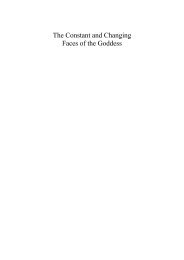The Gentleman, the Virtuoso, the Inquirer - Cambridge Scholars ...
The Gentleman, the Virtuoso, the Inquirer - Cambridge Scholars ...
The Gentleman, the Virtuoso, the Inquirer - Cambridge Scholars ...
You also want an ePaper? Increase the reach of your titles
YUMPU automatically turns print PDFs into web optimized ePapers that Google loves.
18<br />
Chapter Two<br />
Lastanosa’s Project<br />
In 1630, a pastor who was tending his flocks in <strong>the</strong> vicinity of <strong>the</strong> town of<br />
Tamarid found a large quantity of silver coins with Spanish characters.<br />
<strong>The</strong> news spread rapidly, and soon people began seeking coins in <strong>the</strong><br />
region. People found many pieces of silver, and <strong>the</strong> findings "enriched<br />
many residents of Tamarid," Silver shops of Zaragoza melted many of<br />
<strong>the</strong>se coins, and so <strong>the</strong> "inquiridores de la Antiguedad," as Lastanosa<br />
called <strong>the</strong> antiquarians, had few coins left to study. 9<br />
<strong>The</strong> discovery of Tamarid put two groups to compete for <strong>the</strong> coins<br />
buried in <strong>the</strong> region: <strong>the</strong> antiquarians and Tamarid’s residents who saw an<br />
opportunity in <strong>the</strong> silver coins of becoming rich—by melting <strong>the</strong>m. About<br />
this last group, we know little. <strong>The</strong>y probably were pastors, like <strong>the</strong> one<br />
found <strong>the</strong> first coins, peasants, and artisans. This was a group of people<br />
who was probably able to appreciate <strong>the</strong> value of <strong>the</strong> coins as antiques, but<br />
preferred <strong>the</strong>ir value in silver. A significant number of people like <strong>the</strong><br />
residents of Tamarid decided, throughout <strong>the</strong> sixteenth century, to seek<br />
<strong>the</strong>ir fortunes in America—<strong>the</strong> left Spain, <strong>the</strong> Old World, in search of<br />
gold, silver, and riches in <strong>the</strong> New World. I am not arguing that <strong>the</strong> actual<br />
residents of Tamarid left for <strong>the</strong> New World, probably few of <strong>the</strong>m left<br />
because it was more difficult for people from Aragon to migrate to <strong>the</strong><br />
New World than people from Castile. After all, American felt under <strong>the</strong><br />
crown of Castile, and legally it was easier for Castilians to migrate to <strong>the</strong><br />
New World. My point is simple. <strong>The</strong>re are at least two cultures in place in<br />
Aragon, and <strong>the</strong> Spanish empire in general: <strong>the</strong> elite, high-culture of <strong>the</strong><br />
“inquiridores de la Antiguedad,” and <strong>the</strong> artisan, entrepreneurial culture of<br />
peasants and artisans. I fur<strong>the</strong>r argue that <strong>the</strong>y had a different relationship<br />
with time, <strong>the</strong> first group looked to <strong>the</strong> past, <strong>the</strong> second group looked to<br />
<strong>the</strong> future.<br />
More is known about <strong>the</strong> inquiridores de la Antiguedad: Don Juan de<br />
Lastanosa Vicencio was one of <strong>the</strong>m. He lived few hundred kilometers<br />
from Tamarid, in Huesca. His encounter with <strong>the</strong> coins of Tamarid would<br />
result in his life-long interest in coins, medals, books, and curiosities. Most<br />
antiquarians stayed in Spain: <strong>the</strong>y project to collect antiques was a project<br />
intrinsically connected to <strong>the</strong> creation of a Spanish past that could be<br />
related to <strong>the</strong> 1640s situation of Spain.<br />
<strong>The</strong> artisans and peasants who melted <strong>the</strong> coins and <strong>the</strong> antiquarians<br />
who preserved for <strong>the</strong>ir museums represent two different ways of<br />
understanding nature yet <strong>the</strong>y shared a similar method—empirical<br />
method—to study it.

















